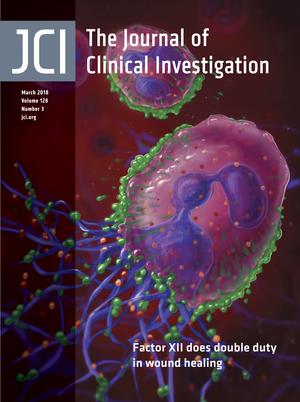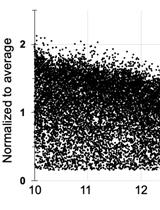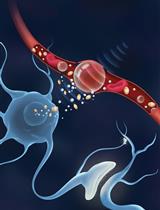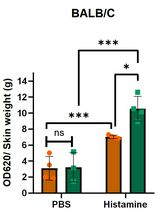- EN - English
- CN - 中文
Vascular Permeability Assay in Human Coronary and Mouse Brachiocephalic Arteries
人冠状动脉和鼠头臂动脉的血管渗透性检测
发布: 2018年10月20日第8卷第20期 DOI: 10.21769/BioProtoc.3048 浏览次数: 6830
评审: Jia Lisonal arvind patelChen Huei Leo
Abstract
Coronary artery disease remains an important cause of morbidity and mortality. Previous work, including ours, has focused on the role of intraplaque hemorrhage, particularly from immature microvessel angiogenesis, as an important contributor to plaque progression via increases in vascular permeability leading to further intraplaque hemorrhage, which increases red cell membrane-derived free cholesterol in plaque content and inflammatory cell recruitment. Evans Blue Dye (EBD) assay is widely used as a standard assay for vasculature permeability. However, the method has not been established in fresh human coronary artery autopsy samples to evaluate intraplaque microvessel permeability and angiogenesis. In this protocol, we describe a method to evaluate human coronary samples for microvascular permeability, including procedures to perfuse coronary arteries, collection of artery samples for histological analysis and immunostaining as well as the use of appropriate methodology to analyze the images. An optional procedure is also provided for the use of FITC-dextran in mouse model to evaluate vascular permeability. These Evans Blue Dye procedures may be useful in providing functional measure of the endothelium integrity and permeability in both human samples and animal models in various pathological conditions.
Keywords: Coronary artery disease (冠心病)Background
Vascular endothelial cells actively regulate the infiltration of plasma constituents and circulating cells, including leukocytes, from blood to sub-endothelial tissues. This mechanism is generally considered to be a critical step of initiation and progression of atherosclerosis (Mundi et al., 2018). The regulation of vascular permeability is achieved through the coordinated opening and closure of endothelial cell-cell junctions. In several diseased conditions, endogenous agents such as histamine, thrombin, and vascular endothelial growth factors (VEGF) dramatically, but reversibly, alter the function and organization of cell-cell junctional complexes in diverse ways, resulting in various degrees of increase in permeability (Dejana et al., 2008). We recently demonstrated a unique mechanism, by which CD163-positive alternative macrophages [M(Hb)] engulf hemoglobin-haptoglobin complexes at the sites of intra-plaque hemorrhage (IPH), promoting the release of vascular endothelial growth factor (VEGF), which further causes internalization of vascular endothelial cadherin (VE-cad) from inter-cellular adherens junctions, thus increasing vascular permeability and leading to atherosclerotic plaque progression (Guo et al., 2018). In the aforementioned study, we conducted a novel technique to assess vascular permeability of human coronary arteries by using Evans Blue Dye (EBD) solution. In the same study, FITC-dextran was used as an alternative indicator in one-year-old apoE mouse model to demonstrate the intraplaque hemorrhage in brachiocephalic artery, due to the small size of the mouse arteries and dye sensitivity required for confocal imaging.
Among the vast range of blue dyes that were created during the 20th century, EBD has been the one with the longest biological history since its first application by Herbert McLean Evans in 1914 (Evans and Schulemann, 1914). EBD is an alkaline synthetic bis-azo (benzidine group) with a molecular weight of 961 Da., and high water solubility, allowing the dye to quickly diffuse throughout the blood stream. Most importantly, when the dye is injected intravenously, it has a high affinity for plasma albumin, giving the dye the ability to remain stable and remain distributed throughout the body for a longer time as a result of a slow excretion rate. All the features of EBD allow it to be an extraordinary agent with multiple potential applications in biomedicine as recently reviewed by Linpeng Yao (Yao et al., 2018). These include but are not limited to estimation of plasma volume, identification of tumors and lymph nodes and as a potential marker of vessel permeability by the use of fluorescence when exposed to green light (Hamer et al., 2002). The principles behind the use of EBD in assays to determine vascular permeability lies in the fact that in normal tissues with normal vascular integrity, albumin is not able to migrate out into the interstitium through the vessel wall endothelial layer. This means that in cases of Albumin-EBD complex, the dye would be limited only to circulation. EBD is relatively non-toxic when used in appropriate concentrations. In vivo experiments using both mice and human subjects have demonstrated that when used in excess, albumin reaches its maximum percent of saturation causing vascular leakage and resulting in a rapid bluish discoloration of tissues (Miles and Miles, 1952). In normal conditions, an adequate permeability barrier is maintained through tight cell-to-cell adherens junctions that are strictly controlled by growth factors, cytokines and other molecules (Radu and Chernoff, 2013). However, in pathological conditions where the integrity of the endothelial layer is affected, plasma proteins including albumin, are able to leak out the vessels as may occur in various disease states. The most common pathophysiological event leading to an increase vascular permeability is acute inflammation which may occur when the vascular wall including the endothelial layer is injured. Vasodilatation, increase in blood flow, disruption of endothelial cell junctions and infiltration of leukocytes are the key players in this process. The EBD-Albumin complex can be seen microscopically as basophilic color in interstitial tissues and indicated increased vascular permeability. In our recent study on endothelial barrier dysfunction after drug-eluting stents implantation, EBD perfusion was performed in rabbit iliac artery stenting model to demonstrate the arteries permeability is associated with poor endothelial VE-cadherin/P120 junctions and higher macrophage infiltration (Harari et al., 2018). Given the advantages of EBD, we decided to use the technique to study the human coronary arteries permeability.
Materials and Reagents
- Pipette tips
- 250 ml Stericup filter unit (Merck, catalog number: SCGPU02RE )
- Coverslips (Fisher Scientific, catalog number: 12-543D )
- Kimwipes (KCWW, Kimberly-Clark, catalog number: 34155 )
- Ultra-fine Syringe (BD, catalog number: 324911 )
- Human coronary artery samples selected from freshly collected autopsy specimens (from the CVPath Registry)
- [Optional] One-year-old apoE knockout (KO) mouse (THE JACKSON LABORATORY, catalog number: 002052 )
- EcoMount (Biocare Medical, catalog number: EM897L )
- CoverMount for non-EBD staining, Xylene based (Avantik, catalog number: SL6012-A )
- Evans blue dye (Sigma-Aldrich, catalog number: E2129-50G )
- FITC-dextran (Sigma-Aldrich, catalog number: 46945 )
- 5% BSA (Fisher, catalog number: BP1600-100 )
- PBS (1x, Ultra Pure Grade, VWR, catalog number: 97063-658 )
- Neutral buffered formalin (NBF) (Sigma-Aldrich, catalog number: HT501128 )
- Tissue-Tek® O.C.T. Compound (Sakura Finetek, Miles, catalog number: 4583 )
- Hydrogen peroxide H2O2 3% (VWR, catalog number: BDH7540-2 )
- Dako protein block (Agilent Technologies, DAKO, catalog number: X0909 )
- CD163 antibody (Santa Cruz Biotechnology, catalog number: sc-20066 , clone GHI/61)
- CD68 antibody (Dako, clone Kp1)
- Von Willebrand factor (vWF) antibody (SDIX, Strategic BioSolutions, catalog number: S4003GND1 )
- Hypoxia induced factor 1α (HIF1α) antibody (Novus Biologicals, catalog number: NB100-105 )
- Vascular endothelial growth factor-A (VEGF-A) antibody (BioGenex, catalog number: PU483-UP )
- VE-cadherin antibody (R&D Systems, catalog number: AF1002 , dilution 1:100, and BD Biosciences, catalog number: 555661 )
- Vascular cell adhesion protein (VCAM) antibody (Abcam, catalog number: ab134047 )
- CD3 antibody (Roche Diagnostics, catalog number: 790-4341 , prediluted)
- Biotinylated goat anti-rabbit, horse anti-mouse, and rabbit anti-goat (Vector Laboratories, catalog numbers: BA-1000 , BA-2000 , BA-5000 , respectively)
- Alexa Flour 488 and 555 streptavidin (Thermo Fisher Scientific, InvitrogenTM, catalog numbers: S32354 and S32355 , respectively)
- DAPI (Thermo Fisher Scientific, InvitrogenTM, catalog number: D3571 )
- 2-methylbutane (Spectrum Chemical Manufacturing, catalog number: M1246 )
- Liquid nitrogen
- 20% paraformaldehyde (Electron Microscopy Sciences, catalog number: 15713-S )
- Acetone (Fisher Scientific, catalog number: A929-1 )
- Liquid blocker (Ted Pella, catalog number: 22309 )
- Glacial acetic acid (Fisher Scientific, catalog number: A38-212 )
- Hematoxylin and Eosin
- Xylene, Reagent grade/ACS (Avantik, catalog number: RS4050 )
- Mounting media/Permount (Fisher Scientific, catalog number: SP15-500 )
- Deionized water from laboratory
- Mayer’s Hematoxylin Solution (Astral Diagnostics, catalog number: 7020 )
- Gill 3 (Sigma, catalog number: GHS3128 )
- Eosin-phloxine stain (Astral Diagnostics, catalog number: 7010 )
- 100% reagent alcohol (Avantik, catalog number: RS4029 )
- 95% reagent grade alcohol (Avantik, catalog number: RS4031 )
- Ammonium hydroxide, ACS grade (Sigma-Aldrich, catalog number: A6899 )
- Evans blue dye solution (see Recipes)
Equipment
- Pipettes
- Belly button shaker (IBI Scientific)
- Axio Scan.Z1 digital slide scanner (Carl Zeiss, catalog number: Axio Scan.Z1 )
- Bright OTF 5000 microtome cryostat (Hacker Instruments, Hacker, catalog number: OTF 5000 ) using sectioning blades (Thermo Fisher Scientific, catalog number: 3152735 )
- CryoJane tape transfer system (Leica Biosystems, catalog number: 39475205 )
- LSM 800 confocal laser scanning microscope (Carl Zeiss, catalog number: LSM 800 )
- Olympus BX51 microscope (Olympus, model: BX51 )
- RNAscope Probe-Hs-CD163-C2 (Advanced Cell Diagnostics, catalog number: 417061-C2 )
- RNAscope Probe-Hs-VEGFA (Advanced Cell Diagnostics, catalog number: 423161 )
- TLE series ultra-low freezer (Thermo Fisher Scientific, Thermo ScientificTM, catalog number: TLE60086A )
- Stemi DV4 Stereo dissecting microscope (ZEISS, model: Stemi DV4 )
Software
- HALO Image Analysis Platform (Indica Labs) version 2.0
- Zen Blue 2012 (Carl Zeiss) version 2.0
- Zen Black 2012 (Carl Zeiss) version 2.0
Procedure
文章信息
版权信息
© 2018 The Authors; exclusive licensee Bio-protocol LLC.
如何引用
Guo, L., Fernandez, R., Sakamoto, A., Cornelissen, A., Paek, K. H., Lee, P. J., Weinstein, L. M., Collado-Rivera, C. J., Harari, E., Kutys, R., Samuda, T. S., Singer, N. A., Kutyna, M. D., Kolodgie, F. D., Virmani, R. and Finn, A. V. (2018). Vascular Permeability Assay in Human Coronary and Mouse Brachiocephalic Arteries. Bio-protocol 8(20): e3048. DOI: 10.21769/BioProtoc.3048.
分类
细胞生物学 > 组织分析 > 生理学
您对这篇实验方法有问题吗?
在此处发布您的问题,我们将邀请本文作者来回答。同时,我们会将您的问题发布到Bio-protocol Exchange,以便寻求社区成员的帮助。
提问指南
+ 问题描述
写下详细的问题描述,包括所有有助于他人回答您问题的信息(例如实验过程、条件和相关图像等)。
Share
Bluesky
X
Copy link












